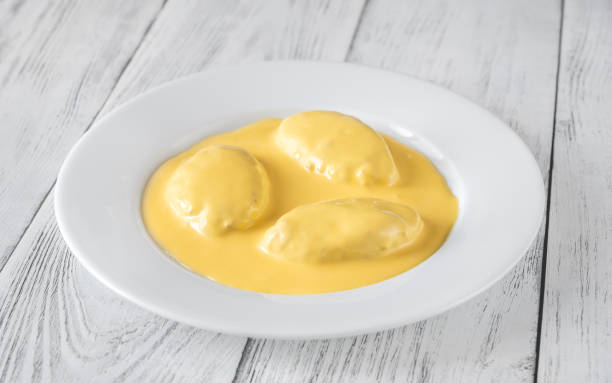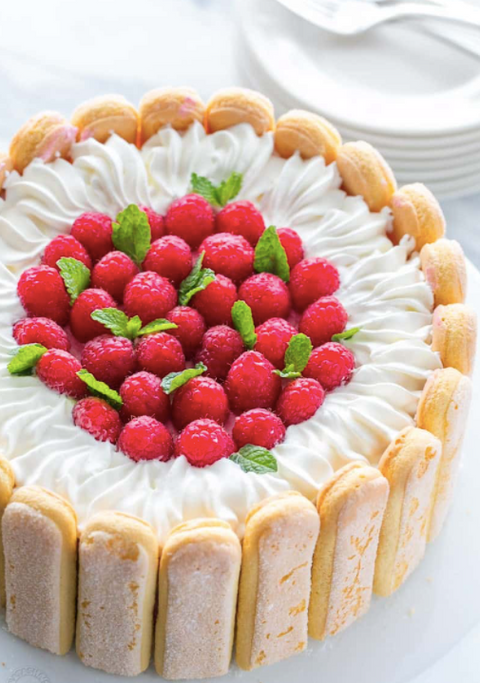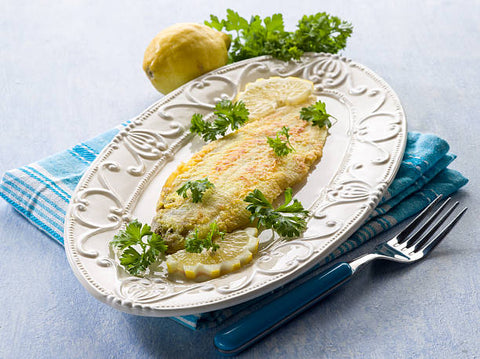Quenelles are delicate, oval-shaped dumplings. The term "quenelle" originally referred to a specific dumpling made with pike and cream. Nowadays, the term is used much more loosely and refers to dumplings made from all ingredients.
Quenelles can be served as a side dish, such as potatoes, or as an appetizer. They can also be found in soups and sauces, and Quenelles are traditionally presented on their sides rather than flat.
Some recipes call for the quenelles to be poached in water or stock and then baked. Others call for them to be poached and then sauteed in butter.
Quenelles has remained a mystery in the past
The French dish of quenelles is a bit of a mystery to the uninitiated. A quenelle is a small oval-shaped dumpling made from pike or other white fish, served in various sauces. The dish has been popular for about 300 years and has been served in many different variations.
- The first thing that confuses people about quenelles is their shape, and they are usually described as ovals, but they look more like footballs. They can be huge or tiny and made from almost any type of food you have around, although pike is the most popular choice.
- The second thing that confuses people is not considered a soup or stew. The French word "quenelle" means "dumpling," which is actually what they are. They are made by combining some meat with eggs, breadcrumbs, and seasoning and then baking them in the oven until they are golden brown on the outside and soft inside.
While quenelles are often served in soups, stews, and casseroles, one of the most famous dishes to feature quenelles is called "Quenelles de Brochet Sauce Nantua.
What do you mean by Quenelles?
The most basic meaning of quenelle is the process of making oval-shaped dumplings with a spoon and your fingers, usually from light fish forcemeat or a vegetable purée. Quenelle can also refer to the finished shape itself, even as an adjective that means "shaped like a quenelle."
There isn't much difference between the terms quenelle and dumpling in cooking. A dumpling is more generally defined as any food formed into a small ball or patty before being cooked; while a quenelle is more specific in that it refers to the method they are created. Dumplings are sometimes made with dough, but they may also be made using ground meat, vegetables, or other ingredients. In addition to sharing them with your hands, you can also form them using ice cream scoops, melon ballers, or other tools. You may have even seen quenelles in frozen food sections at your local grocery store, where balls of mashed potatoes are sold for use on top of Shepherd's Pie and other casseroles.
How to Make Quenelles
Making quenelles is simple if you have the right equipment and technique. Start by putting the forcemeat into a piping bag.
Quenelles are a lightly poached dumpling, classically made out of white fish and pike, which is then puréed into a smooth paste and added to the broth. They're served in soups or with sauces. As you might imagine, they take some practice to make.
Quenelles have become a catch-all term for dumplings that aren't formed into a perfectly round shape in the past few centuries. According to Larousse Gastronomique, the first edition of the definitive French culinary reference book, quenelles can be oblong or oval, triangular, or even square. Some recipes call for adding egg whites to give them structure; others rely on creamed butter or flour to help bind them together.
Making quenelles isn't hard if you have a food processor and some molds. For this recipe, I molded the puréed fish by hand into egg-shaped pieces and poached them before adding them to the soup. As long as you don't overwork your fish mixture—so keep your purée smooth—you can shape these any way you like: in balls with an ice cream scoop, for instance, or simply by spoon.
Taste of quenelles
Quenelles are a dumpling style, but that doesn't get at what they mean to me. They're more delicate, too, and with some dishes, they garnish. But they can be the star of the show on their own.
I use quenelles as a sauce sopper-upper. Cooked potatoes are pureed with chicken stock and cold butter to make them smooth. Then, add chopped herbs and fold in beaten egg whites to lighten the mixture.
What are quenelles made of?
A quenelle is a combination of fish, eggs, butter, and breadcrumbs mixed to form a paste. The paste is then shaped into an oval-like form and boiled.
The term may also refer to the same preparation when served in soup or as a sauce. The word quenelle is borrowed from the French word for "dumpling."
In France, this kind of preparation was first made with pike (French: Brochet), but nowadays, it can be made with other fishes like cod or salmon. The pike does not contribute to the dish's taste but provides structure and character.
Difference between a Roach and a Quenelle
In the world of food, two things come to mind when someone mentions a "roach": an insect and a reference to food. The latter are found in the French cooking tradition and can describe a variety of dishes.
- The quenelle is one such dish. While it is similar to a dumpling, it is more delicate. Typically made with pike, the quenelle is poached in water or milk, and then served in a white sauce seasoned with lemon juice, nutmeg, and parsley.
- In French cuisine, you'll also find quenelles served as dessert. These sweet versions are made with ground almonds, egg whites, and sugar. The quenelles are steamed and then filled with fruit sauces or candied fruits.
- To make quenelles, start with a whole roach. Cut it in half lengthwise and remove the pin bones — the bones across the center of the fillet that connects the two halves.The quenelle cut is done by cutting each of the two halves into thirds widthwise. When you're done, you should be left with six fillets total, and they'll be about 3 ounces each, making them perfect for individual serving sizes.

Freezing Quenelles
In this case, quenelles can be frozen and reheated.
Quenelles are usually made from fish or poultry, sometimes with fat such as butter or cream. They can be poached in water or court bouillon or baked in the oven. Quenelles can also be served dry by sauteing them or frying them in a pan that has been lightly greased. Remember to wrap them individually when freezing quenelles, so they don't stick together. This will make it easy to remove a single quenelle when needed. Wrapping them individually will also help protect the delicate crust they may have developed during the cooking process. To freeze quenelles:
- Place a piece of plastic wrap on a cutting board or another flat surface.
- Place an individual quenelle in the center of the plastic wrap and fold one side over to cover about half of it.
- Fold the other side over it to completely cover it with plastic wrap.
- Roll up into a tight cylinder shape and twist both ends as if wrapping up a candy bar. This will help keep the air out and reduce freezer burn damage caused by oxygen exposure.
- Repeat until all of your quenelles
While it is possible to freeze quenelles, it may not result in the same quality end product.
This is because quenelles are a delicate combination of meat and filler. When you add liquid to quenelles, you may notice the texture will change.
When you freeze the quenelles, the water expands and can change its texture and shape.
Shapes of Quenelle
Quenelles can be formed into various shapes, including cylindrical and conical. For larger quenelles, the hands are used to create the desired profile; for smaller quenelles, a spoon is used. When made with fish, a buttered mold is often used. The most common shape is a broad cylinder, typically three to four centimeters in diameter and eight centimeters long. The quenelle's specific shape depends on the desired use; different forms serve different purposes in cuisine.
There are three ways to shape quenelles:
The cuillère, the couteau, and the cornet
- The cuillère is shaped by spooning a small amount of forcemeat into a large spoon and pushing it off with a second spoon.
- The couteau is made by using two knives, one in each hand. A small amount of forcemeat is placed on the tip of one knife and pushed off with the other.
- The cornet is made by cutting a piece of thick parchment paper into a cone, filling it with forcemeat, and then pushing it out from the bottom of the cone.
Sauces for Quenelles
Sauces for quenelles are of two kinds: those used hot and those used cold.
- Sauces that are used hot with quenelle dishes do not need to be thick, and the sauce should be reduced a little and be just as liquid as it will flow easily off the spoon. Most fish sauces can serve, such as white sauce, hollandaise, mousseline, béchamel with cream, etc.
- The cold sauces must be thick enough to coat the back of a spoon, and they may be prepared in advance and kept in a cool place until required. When they are to be used, they should be warmed slightly because they will then adhere better to the fish. A few examples of cold sauces include oyster liquor, lemon juice, butter, and herbs
Quenelle de Sole - Quenelle of Sole (or other white fish)
To make this dish, one would prepare six quenelles of sole, poach them carefully in boiling salted water, remove them to a hot dish, add half a pint of oyster liquor to the poaching liquid and reduce by two thirds. Then strain the reduction into another pan containing one glass of white wine, one sliced onion, and two bay leaves. Simmer until reduced by half again. While reducing the sauce, thicken five fluid ounces of the reduction with two fluid ounces of butter kneaded smoothly with two teaspoons of flour. Strain through a sieve into the finished drop. Stir in four tablespoons of cream and season to taste before adding the quenelles to reheat in the finished sauce.
Wines that go well with Quenelles
The pairing of food and wine has been the subject of much discussion, debate, and literature. Wine can be paired with food based on the "weight" or "body" of wine, the flavor intensity of the wine, the texture and richness of the food, and even color.
Quenelles are small dumplings made from a mixture of fish or poultry purée and egg, poached in stock or water to create a smooth oval shape.
- Wine Pairings for Quenelles
White wines are usually recommended for fish-based dishes, particularly delicate white wines such as Riesling, sauvignon Blanc, or viognier. A more potent, richly flavoured white wine such as Semillon or chardonnay would also match well with most quenelles, especially ones served with a creamy sauce.
Champagne is an excellent choice for quenelles made with caviar. Red wines are not recommended for quenelles since they have no tannins that complement fish-based dishes.
Serving Quenelles
A quenelle is a dumpling made of fish or chicken, sometimes mixed with breadcrumbs, and poached in stock or water. Before cooking, the dumplings are generally shaped into egg or tear forms, and Quenelles are usually served in soup or sauce. They may be free-formed on the plate or molded into a form such as a sausage shape.
Quenelles can be served cold or hot. They are often served with a sauce based on the dish's accompanying ingredients and flavors. They can be sweetened with sugar to accompany chocolate sauce or other desserts. In any case, it is traditional for the quenelles to be covered with the sauce and accompanied by their cooking liquid as a type of consommé.
The preparation of quenelles by hand is time-consuming and requires considerable skill. For this reason, they have become an expensive delicacy, which accounts for their rarity in restaurants today. However, they can be purchased ready-made from some high-end stores and supermarkets, either refrigerated or frozen.
These quenelles are easy to make, so try these delicate quenelles!




